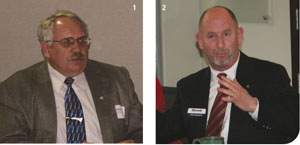
1. Savvy companies, said Dave Kendrick, use the slow periods to upgrade their workers' skills. | 2. Ernie Straub said federal policymakers and banking regulators need to align their efforts.
Tony Rohr introduced another variable: the potential spike in cost if a major vendor fails during the course of a project. “It makes the conversation on the table with this economy more delicate because you don’t know how stable those bids are.” Warned Ernie Straub, “Make sure all your vendors are paying their bills.” Scott Vath, vice president of operations for Titan Construction, introduced an additional worry: subcontractors who are not bonded.
Excel Constructors, said Mike Johnson, monitors every single vendor every month on every project. “I don’t think we can assume it’s just going to be the small contractor that is going to fail,” said Johnson.
Surety bonds do not necessarily solve the problem. “No owner has ever come out ahead by having to go to a bonding company,” said Susan McGreevy. “Even if they end up paying every dime, you know it’s going to take you at least another six months just because of the process.” McGreevy argued for the value of pre-qualifying.
Joe Mabin offered a caveat: “It doesn’t always work as well for minority and women contractors, the whole pre-qualification process, because it excludes.”
If the spread problem needed confir-mation, Pribyl got it while sitting at the table. Bids had just been posted for a public works project at the intersection of Troost and Brush Creek. The bids ranged from $9.8 million to $12.8 million.
“That’s a pretty good size spread,” Pribyl said, “and I think that’s the feeling of the group what we go up against every day.”
Labor
David Kendrick, business manager for the Greater Kansas City Building and Construction Trades Council, noted that many organizations had taken this opportunity of a slow period to bring workers back into the training programs and upgrade their skills, making them more marketable once the economy turns around. The various green initiatives and advances in the mechanical and electrical trades make this useful. “When you’re down, you go back to school,” he said.
One advantage to owners right now, added Dan Euston, is that only the best workers are working, so the productivity is the best it might ever be. He worries, though, that the current slowdown will so discourage young workers that “we
are going to lose a generation of people who are afraid to get into the trades.”
Explained Dave Rezac, a principal with 360 Architects, firms can be strategic with their first or the second layoff and do some house-cleaning along the way, but beyond that, some very talented people will be turned out of the industry.
And as Don Greenwell noted, the age of the work force skews into its 50s. The longer this downturn goes on, the more of these workers will leave the industry for good. “The next generation coming in is an imperative for the industry.”
Regulatory Environment
The question was posed to the group as to whether there were any regulatory changes they would recommend to spur the economy in general and new building in particular.
Mark Huber, special projects division manager for Turner Construction, addressed the permitting process. As he sees it, some jurisdictions have used the slowdown to expedite permitting. Others, however, “have a lot of free time on their hands and can make our lives miserable.” He cited Johnson County and Overland Park as good jurisdictions to work with.
Dave Rezac cited permitting issues with sustainable design and green building practices. “The process is drawn out, “he noted, “and the amount of paperwork they ask for seems to be growing every time.”
“The elephant in the room that no one has mentioned yet is the bank regulators,” said Augie Huber. As he explained, when regulators are working with the banks, they increase equity requirements. It used to be if someone wanted to build a new manufacturing plant or nursing home, they could get by with 25 percent equity or sometimes less. Now, it’s 50 percent. That problem will not right itself, Huber argued, “until the regulators back off a little bit, and the bankers get a little more comfortable with the fact that the market isn’t continuing to go down.”
Susan McGreevy explained what had led to this impasse. At the same time the government was pushing through TARP to get money into the banks, various federal regulators were telling them not to lend it. “So you’ve got a disconnect,” said McGreevy, “between two sides of the government operating at cross-purposes. If that money had been allowed—even part of it—to get out into the lending community, we wouldn’t be having as serious conversation as we are having.”
“The regulators and the feds are totally disconnected, 100 percent,” affirmed Ernie Straub. “They are off 180 degrees, and until they get it together, construction lending just isn’t going to happen.”
Aaron Neighbors agreed. “We need to have the [regulatory] pendulum swing back at least quasi to the center. Until that happens, I don’t think we are going to get out of this thing.”
(...continued)